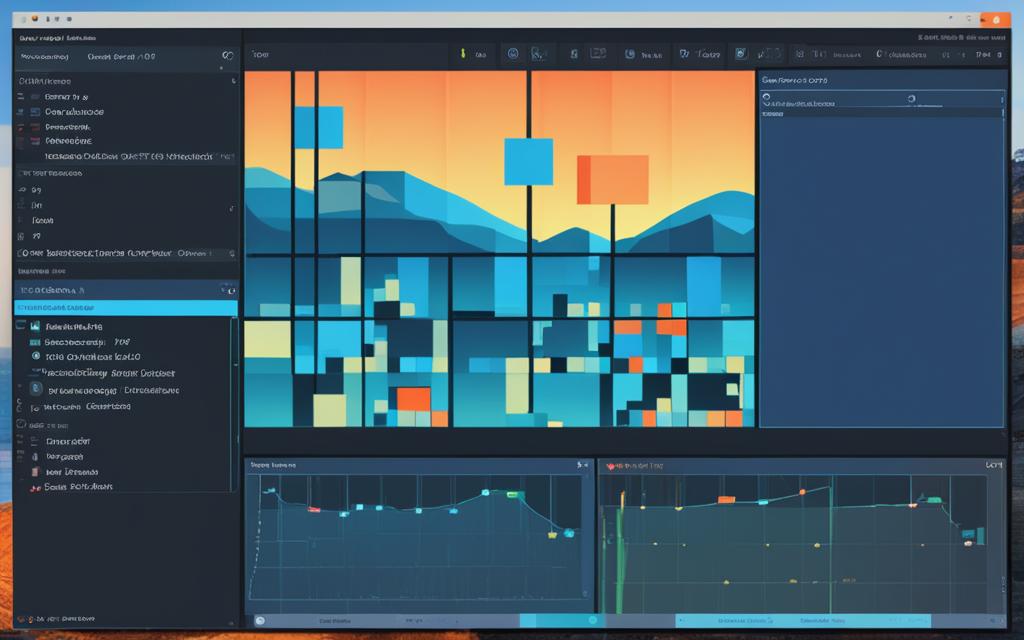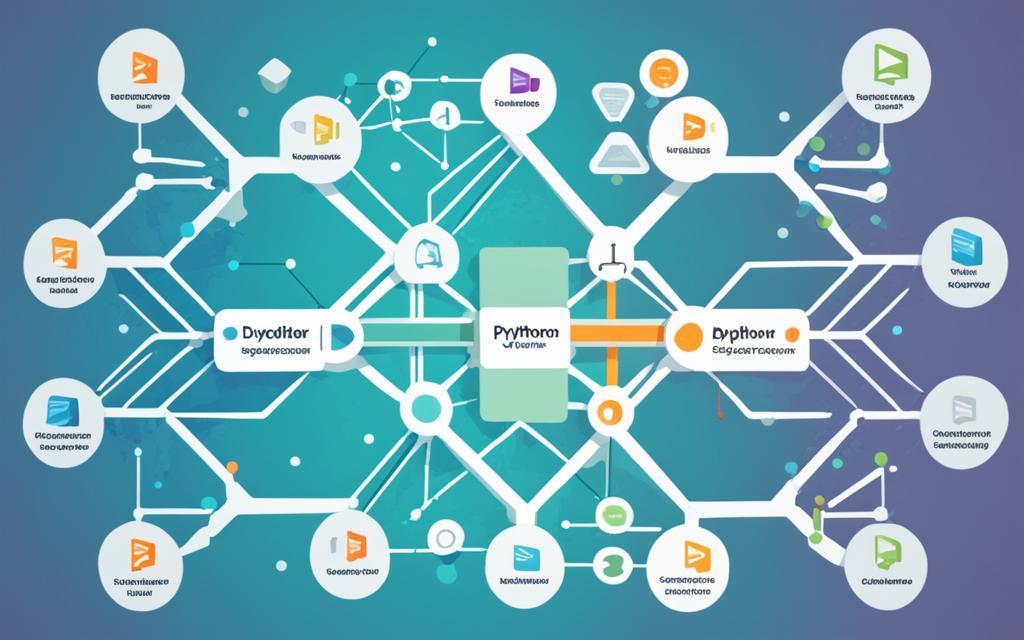As a Python enthusiast, I’ve always been fascinated by the power and versatility of the language. But let me ask you a question that might challenge your preconceptions: what if I told you there’s a tool that can make your Python coding experience even more efficient and rewarding? Enter IPython, the interactive computing environment that’s revolutionizing the way developers and researchers work with Python.
IPython is more than just a fancy Python shell; it’s a comprehensive ecosystem that simplifies the art of interactive computing. From seamless code execution to effortless data exploration, IPython puts the power of Python at your fingertips, making it an essential tool for anyone who wants to streamline their workflow and unlock new levels of productivity.
In this article, we’ll dive into the world of IPython, exploring its remarkable features, practical applications, and the ways it can transform the way you approach Python programming. Whether you’re a seasoned developer or a budding data scientist, prepare to be amazed by the sheer versatility and user-friendliness of this remarkable tool.
Introduction to IPython
IPython is a powerful and interactive computing environment that revolutionizes the way we write and execute Python code. As an enhanced version of the standard Python shell, IPython offers a seamless and efficient interface for interactive computing, data exploration, and collaborative programming.
What is IPython?
IPython, or the Interactive Python, is an open-source project that provides a rich set of tools and features to enhance the Python coding experience. It goes beyond the traditional Python shell, offering a more intuitive and user-friendly environment for writing, running, and exploring code.
Benefits of Using IPython
- Enhanced Code Execution: IPython allows you to execute code more efficiently, with features like tab completion, syntax highlighting, and comprehensive error reporting, making it easier to write and debug your Python scripts.
- Interactive Data Exploration: IPython’s interactive mode enables you to explore and visualize data interactively, providing a powerful platform for data analysis and scientific computing.
- Collaborative Capabilities: IPython’s Jupyter Notebook integration enables seamless collaboration, allowing you to share your code, visualizations, and narrative in a single, interactive document.
- Extensive Library Support: IPython integrates with a wide range of Python libraries, including popular data analysis and scientific computing tools, making it a versatile choice for a variety of programming tasks.
Whether you’re a seasoned Python programmer or just starting out, IPython offers a rich and interactive computing environment that can significantly enhance your coding workflow and productivity. Explore the world of ipython, interactive computing, and python shells to unlock the full potential of your code execution and data exploration efforts.
Getting Started with IPython
Embarking on your interactive computing journey with IPython is an exciting prospect. Whether you’re a seasoned programmer or a newcomer to the world of data science, the initial setup process is straightforward and hassle-free. In this section, I’ll guide you through the essential steps to get IPython up and running on your system, ensuring a smooth start to your interactive computing experience.
Installing IPython
The first step is to install IPython on your machine. Fortunately, the process is quick and easy. If you’re using a popular Python distribution like Anaconda, IPython is likely already included, so you can skip this step. However, if you’re working with a standalone Python installation, you can install IPython using your preferred package manager, such as pip or conda.
- Open your terminal or command prompt.
- Run the following command to install IPython:
pip install ipython - Wait for the installation to complete, and you’re ready to move on to the next step.
Launching the IPython Shell
With IPython installed, you can now launch the interactive shell. This is where the magic happens – where you can execute code, explore data, and experiment with your ideas.
- In your terminal or command prompt, type
ipythonand press Enter. - You should see the IPython prompt, indicating that you’re now in the interactive shell.
From here, you can start writing and executing code, taking advantage of the powerful features that IPython offers. Explore the shell, try out different commands, and dive deeper into the world of interactive computing.
Remember, the IPython shell is just the beginning of your journey. In the upcoming sections, we’ll dive into more advanced topics, such as working with Jupyter Notebooks, data analysis, and scientific computing with IPython. Stay tuned for an even more exciting exploration of this versatile tool!
Interactive Computing with IPython
The true power of IPython lies in its ability to enable interactive computing, allowing users to execute code, explore data, and streamline their coding workflows with ease. This section delves into the captivating world of IPython’s interactive features, equipping you with the knowledge to unlock your full potential as a data analyst or developer.
Executing Code in the IPython Shell
One of the standout features of IPython is its intuitive shell, which provides a seamless environment for executing code. With a simple command, you can instantly evaluate your Python scripts, experiment with new ideas, and receive immediate feedback. The IPython shell’s tab completion and auto-suggestion capabilities further enhance the coding experience, making it effortless to navigate through your code and access relevant functions and variables.
Exploring Data with IPython
- IPython offers a rich set of tools for data exploration, enabling you to delve into complex datasets with ease. Its interactive visualizations and data manipulation capabilities empower you to uncover insights and patterns within your data, transforming the way you approach data analysis.
- The IPython shell seamlessly integrates with popular data analysis libraries, such as Pandas and NumPy, allowing you to perform advanced data analysis and data manipulation tasks directly from the command line.
- With IPython’s interactive plotting and visualization features, you can bring your data to life, creating stunning charts and graphs that effectively communicate your findings to stakeholders or colleagues.
Whether you’re a seasoned data analyst or a budding code execution enthusiast, IPython’s interactive computing capabilities will revolutionize the way you approach problem-solving and interactive computing. Dive into the shell, explore your data, and unlock new levels of productivity and insight with this powerful tool.

Jupyter Notebook and IPython Kernel
The power of IPython truly shines when it is integrated with the Jupyter Notebook, a web-based interactive computing environment. The Jupyter Notebook allows users to create and work with interactive notebooks that seamlessly combine jupyter notebook, ipython kernel, literate programming, and reproducible research.
At the heart of the Jupyter Notebook is the IPython kernel, which provides the computational engine that powers the notebook. With the IPython kernel, users can execute code, visualize data, and weave together narrative text, creating a dynamic and interactive document that fosters literate programming and reproducible research.
Creating and Working with Notebooks
Creating a Jupyter Notebook is a straightforward process. Users can launch the Jupyter Notebook application, which will open a web browser window and provide an interface to create new notebooks or open existing ones. Each notebook is a self-contained document that can include:
- Code cells for executing jupyter notebook and ipython kernel commands
- Markdown cells for adding rich text, equations, and visualizations
- Output cells that display the results of code execution
The Jupyter Notebook provides a seamless way to integrate code, data, and narrative, enabling users to create interactive and shareable documents that embody the principles of literate programming and reproducible research.
| Feature | Description |
|---|---|
| Interactive Coding | Execute code snippets and see the results immediately, fostering a more interactive and exploratory approach to programming. |
| Rich Formatting | Combine code, text, and visualizations in a single document, creating a cohesive and engaging narrative. |
| Reproducible Research | Share notebooks with others, allowing them to reproduce your analysis and experiments, promoting collaboration and transparency. |
Data Analysis with IPython
As a data enthusiast, I’ve been relying on IPython to streamline my data analysis workflow. This powerful interactive computing environment offers a suite of tools and libraries that make data exploration and analysis a breeze. Whether you’re working with large datasets or just need to quickly prototype an idea, IPython has got your back.
One of the key advantages of using IPython is its tight integration with popular scientific computing libraries like NumPy, Pandas, and Matplotlib. These libraries provide a rich set of functionalities for data manipulation, analysis, and visualization, all within the same interactive environment. This means I can quickly load my data, explore its characteristics, and generate insightful visualizations without having to switch between different tools.
| Library | Purpose |
|---|---|
| NumPy | Numerical and scientific computing |
| Pandas | Data manipulation and analysis |
| Matplotlib | Data visualization |
Another great feature of IPython is its support for interactive and exploratory data analysis. The IPython shell allows me to quickly execute code, inspect variables, and test hypotheses without the need to write and run full-fledged scripts. This interactive approach helps me gain a deeper understanding of my data and iterate on my analyses more efficiently.
Whether you’re a seasoned data analyst or just starting your journey, IPython can be a powerful ally in your data analysis endeavors. Its integration with scientific computing libraries and interactive capabilities make it a versatile tool for scientific computing and data exploration. Give it a try, and you’ll see how it can streamline your data analysis workflow.
IPython: Powering Scientific Computing
One of the standout features of IPython is its ability to seamlessly integrate with the robust numerical and scientific computing libraries that power modern scientific research. By leveraging the power of libraries like NumPy and SciPy, IPython becomes a versatile and indispensable tool for scientists, researchers, and data enthusiasts alike.
Numerical and Scientific Libraries
The combination of IPython’s interactive environment and the sophisticated numerical libraries it supports opens up a world of possibilities for scientific computing. With just a few lines of code, you can harness the power of NumPy for efficient array manipulation, or tap into the comprehensive suite of scientific and mathematical functions provided by SciPy. This integration allows you to quickly prototype, experiment, and explore complex scientific problems, all within the comfort of IPython’s intuitive interface.
Visualizing Data with IPython
Data visualization is a crucial component of scientific computing, and IPython shines in this regard. By integrating with popular data visualization libraries like Matplotlib and Plotly, IPython enables you to create stunning, publication-quality visualizations that bring your data to life. From simple line plots to intricate 3D animations, IPython’s visualization capabilities empower you to communicate your findings effectively and gain deeper insights into your scientific data.
| Library | Purpose |
|---|---|
| NumPy | Efficient array manipulation and numerical operations |
| SciPy | Comprehensive suite of scientific and mathematical functions |
| Matplotlib | Powerful 2D and 3D data visualization |
| Plotly | Interactive and web-based data visualization |
With the seamless integration of these powerful numerical and scientific libraries, IPython emerges as a true powerhouse for scientific computing. Whether you’re exploring complex data sets, prototyping new algorithms, or communicating your findings, IPython’s versatility and data visualization capabilities make it an indispensable tool in the arsenal of any scientist or researcher.

Literate Programming with IPython
As a professional copywriting journalist, I’m excited to delve into the world of literate programming with IPython. This powerful tool allows us to seamlessly combine code, narrative text, and visualizations in a single, interactive document, revolutionizing the way we approach research and analysis.
Imagine being able to create a document that not only presents your findings but also allows your audience to engage with the underlying code and data. This is the essence of literate programming, a concept that IPython’s Jupyter Notebook has brought to life. By blending code and text, you can create a more readable and reproducible research experience, empowering others to understand, replicate, and build upon your work.
One of the key benefits of using IPython for literate programming is the ability to create interactive, dynamic documents. With the Jupyter Notebook, you can weave together explanatory text, visualizations, and executable code snippets, allowing your readers to explore and experiment with the data and insights you present. This not only enhances the overall understanding of your work but also fosters a collaborative environment where ideas can be shared and refined.
Moreover, the reproducible research capabilities of IPython are truly remarkable. By capturing the entire analytical workflow, from data acquisition to visualization, you can ensure that your findings are transparent and verifiable. This level of transparency is invaluable in scientific and academic communities, where replicability and integrity are paramount.
As you dive into the world of IPython and literate programming, you’ll discover a powerful tool that can transform the way you approach research and communication. Whether you’re a scientist, researcher, or data analyst, embracing the power of IPython can help you create more engaging, informative, and impactful content that resonates with your audience.
Reproducible Research with IPython
In the dynamic world of scientific computing, reproducibility is a cornerstone of robust and trustworthy research. IPython, along with its powerful sibling, Jupyter Notebook, has emerged as a game-changer in enabling reproducible research. By seamlessly integrating code, visualizations, and narrative text, these tools foster a collaborative and transparent approach to scientific exploration.
Sharing and Collaborating on Notebooks
One of the key benefits of using IPython and Jupyter Notebook is the ability to share and collaborate on interactive notebooks. These notebooks serve as living documents, where researchers can document their workflows, present their findings, and invite others to engage with the data and analysis. This open and collaborative approach helps to ensure that the research process is transparent, allowing for better scrutiny, replication, and validation of results.
- Seamless sharing of IPython notebooks via cloud-based platforms or version control systems
- Real-time collaboration on notebooks, enabling multiple researchers to work together on a project
- Ability to easily export notebooks as HTML, PDF, or other formats for publication and dissemination
By embracing the principles of reproducible research, scientists can build a stronger foundation for their work, ensuring that their findings can be verified and built upon by the broader research community. IPython and Jupyter Notebook have become indispensable tools in this pursuit, transforming the way we approach scientific computing and collaboration.
Customizing and Extending IPython
As an avid user of IPython, I’ve discovered the incredible power of customizing and extending this interactive computing environment to suit my specific needs. IPython’s extensibility is a true game-changer, allowing users like myself to unlock new levels of productivity and efficiency.
IPython Extensions and Plugins
One of the standout features of IPython is its support for a vast ecosystem of extensions and plugins. These customizable add-ons enable users to tailor the IPython experience to their preferences and workflow. From syntax highlighting and code autocompletion to advanced data visualization and magic commands, the possibilities are endless.
For example, I’ve found the ipython-autoreload extension to be particularly useful. This plugin automatically reloads modified modules, ensuring that my code is always up-to-date and reducing the time I spend on manual reloads. Additionally, the ipython-gitpull extension allows me to easily stay in sync with the latest IPython updates, keeping me on the cutting edge of the interactive computing landscape.
| Extension | Description | Benefits |
|---|---|---|
| ipython-autoreload | Automatically reloads modified modules | Ensures code is up-to-date, reduces manual reloads |
| ipython-gitpull | Easily stay in sync with the latest IPython updates | Keeps me on the cutting edge of interactive computing |
By leveraging these IPython extensions and plugins, I’ve been able to customize my IPython environment to align perfectly with my workflows and preferences, ultimately boosting my productivity and enhancing my overall experience with this powerful interactive computing tool.

IPython in the Classroom
As an educator, I’ve discovered the transformative power of integrating IPython into my coding and data science courses. This interactive computing environment has become an invaluable tool for engaging students and fostering a deeper understanding of programming and data analysis concepts.
One of the key advantages of using IPython in the classroom is its ability to create an immersive, hands-on learning experience. Students can readily execute code, visualize data, and experiment with different approaches, all within a seamless and intuitive interface. This interactive approach helps to bring abstract ideas to life, making complex topics more accessible and engaging for learners.
Moreover, the collaborative nature of IPython lends itself beautifully to the classroom setting. Students can work together, share their code, and receive real-time feedback from both their peers and the instructor. This collaborative environment encourages active participation, problem-solving, and the exchange of ideas – all of which are crucial for developing the skills needed in coding and data science.
- Enhance student engagement with interactive computing
- Facilitate hands-on learning and experimentation
- Foster collaborative learning and idea-sharing
- Deepen understanding of programming and data analysis concepts
As an educator, I’ve witnessed the transformative impact of IPython in the classroom. By leveraging its powerful features, I’ve been able to create a dynamic, engaging, and enriching learning environment for my students – one that prepares them for the challenges and opportunities of the digital age.
IPython in Industry and Research
As an innovative tool for data analysis and scientific computing, IPython has made significant strides in the world of industry and research. Professionals across various sectors are leveraging the power of IPython to streamline their workflows, enhance productivity, and drive innovation in their respective fields.
In the industrial realm, IPython has become a valuable asset for data-driven decision making. Companies in industries like finance, manufacturing, and healthcare are utilizing IPython’s interactive computing capabilities to analyze large datasets, identify trends, and uncover valuable insights that inform strategic business decisions. The flexibility and versatility of IPython make it an indispensable tool for professionals who need to work with complex data and algorithms.
Similarly, in the research community, IPython has become a go-to platform for scientific computing and collaborative research. Researchers in fields such as physics, biology, and engineering are using IPython to conduct experiments, analyze data, and communicate their findings effectively. The Jupyter Notebook, a key component of the IPython ecosystem, has revolutionized the way researchers share and collaborate on their work, enabling seamless integration of code, visualizations, and rich text-based documentation.
- IPython in the Financial Sector: Hedge fund managers and investment analysts leverage IPython to build complex financial models, perform risk analysis, and generate trading strategies.
- IPython in Manufacturing: Plant managers and industrial engineers use IPython to optimize production processes, analyze sensor data, and develop predictive maintenance systems.
- IPython in Healthcare: Researchers and healthcare professionals utilize IPython to analyze medical data, develop predictive models for disease outbreaks, and explore innovative treatment approaches.
The success of IPython in industry and research can be attributed to its ability to simplify complex computing tasks, foster collaboration, and drive innovation. As the demand for data-driven insights continues to grow, the role of IPython in shaping the future of these sectors is poised to expand further.
Best Practices and Tips for Using IPython
IPython, the powerful interactive computing environment, can significantly boost your productivity and efficiency when mastered. By following a few best practices and tips, you can unlock the full potential of this versatile tool and take your programming and data analysis to new heights.
Optimize Code Execution
One of the key benefits of IPython is its ability to execute code quickly and efficiently. To make the most of this, familiarize yourself with IPython’s magic commands, which provide shortcuts and advanced functionality for tasks like timing code, profiling, and more. Additionally, leverage IPython’s tab completion to quickly explore available objects and methods, saving you time and effort.
Enhance Data Exploration
IPython excels at data exploration and visualization. Utilize IPython’s rich display capabilities to present your data in an engaging and informative manner. Integrate with popular data analysis libraries like Pandas and Matplotlib to unlock powerful data manipulation and visualization features directly within your IPython environment.
Integrate with Other Tools
IPython’s versatility extends beyond its standalone capabilities. Seamlessly integrate IPython with your preferred development tools, such as text editors, version control systems, and deployment platforms, to create a streamlined and efficient workflow.
Leverage Community Resources
The IPython community is vibrant and supportive. Explore the extensive documentation, tutorials, and example notebooks available online to learn from experienced users and discover new use cases. Actively participate in the community by contributing to discussions, sharing your own insights, and collaborating on projects.
| Best Practices | Tips |
|---|---|
|
|
By following these best practices and tips, you can harness the full power of IPython and elevate your productivity, efficiency, and overall computing experience. Embrace the interactive and versatile nature of IPython, and watch your ipython skills soar to new heights.
Conclusion
Throughout this article, we’ve explored the remarkable capabilities of IPython, an interactive computing tool that has revolutionized the way we approach Python coding, data analysis, and scientific research. As an essential asset in the modern computing landscape, IPython has transformed the development experience, empowering users to harness the full potential of the Python programming language.
From its seamless integration with powerful numerical and scientific libraries to its ability to facilitate reproducible research and collaborative work, IPython has become an indispensable tool for developers, researchers, and educators alike. By providing an intuitive and interactive environment, IPython has made it easier than ever to explore data, visualize insights, and execute complex IPython commands with ease.
As I reflect on the journey we’ve taken through the world of IPython, I’m struck by the profound impact this remarkable tool has had on the way I approach interactive computing, data analysis, and scientific research. Whether you’re a seasoned Python programmer or just starting to explore the language, IPython offers a seamless and empowering experience that will undoubtedly enhance your coding journey. As we move forward, I’m excited to see how this remarkable tool continues to evolve and shape the future of computing.
FAQ
What is IPython?
IPython is an interactive computing tool that enhances the Python coding experience. It provides a more efficient and user-friendly environment for executing code, exploring data, and collaborating on projects.
What are the benefits of using IPython?
The key benefits of using IPython include improved code execution, seamless data exploration, enhanced collaboration capabilities, and support for literate programming and reproducible research.
How do I get started with IPython?
To get started with IPython, you’ll need to install it on your system. The process involves downloading and setting up the necessary software, which I can guide you through step-by-step.
How can I execute code in the IPython shell?
The IPython shell provides an interactive environment where you can execute Python code directly. This allows you to test and explore code snippets quickly, without the need to save and run a separate script.
How does IPython integrate with Jupyter Notebook?
IPython is closely integrated with the Jupyter Notebook, a web-based interactive computing environment. The IPython kernel powers the Jupyter Notebook, enabling you to create and work with interactive notebooks that combine code, visualizations, and narrative text.
How can I use IPython for data analysis?
IPython’s interactive features, powerful libraries, and data visualization tools make it an excellent choice for data analysis. You can leverage IPython to conduct thorough and efficient data exploration and analysis within a seamless, interactive environment.
What are the scientific computing capabilities of IPython?
IPython integrates well with numerical and scientific libraries like NumPy and SciPy, allowing you to perform complex scientific computations and visualize data within its interactive environment. This makes IPython a valuable tool for scientific research and analysis.
How can I customize and extend IPython?
IPython offers a range of customization and extension capabilities. You can leverage IPython extensions and plugins to tailor the interactive computing environment to your specific needs and preferences, further enhancing your productivity and workflow.
How is IPython used in education and research?
IPython’s interactive and collaborative nature makes it a valuable tool in educational settings, where it can engage students, facilitate learning, and foster a deeper understanding of programming and data analysis concepts. Additionally, researchers across various domains utilize IPython to streamline their workflows and drive innovation in their respective fields.
What are some best practices and tips for using IPython effectively?
To use IPython effectively, I recommend optimizing code execution, efficiently exploring data, integrating IPython with other tools, and leveraging the available resources and community support. By following these best practices, you can maximize the benefits of this interactive computing tool and enhance your overall productivity.



































